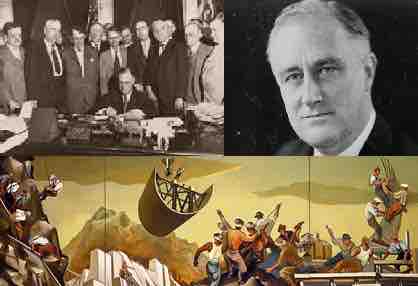Introduction
Modern welfare states include the Nordic countries, such as Iceland, Sweden, Norway, Denmark, and Finland which employ a system known as the Nordic model. The welfare state involves a transfer of funds from the state, to the services provided – examples include healthcare, education and housing – as well as directly to individuals. The welfare state is funded through redistributionist taxation and is often referred to as a type of "mixed economy."
Three types of Welfare States
According to the Political Scientist Esping-Andersen, there are three ways of organizing a welfare state instead of only two. Esping-Andersen constructed the welfare regime typology acknowledging the ideational importance and power of the three dominant political movements of the long 20th century in Western Europe and North America: Social Democracy, Christian Democracy and Liberalism. The ideal Social-Democratic welfare state is based on the principle of universalism granting access to benefits and services based on citizenship. Such a welfare state is said to provide a relatively high degree of autonomy, limiting the reliance of family and market. In this context, social policies are perceived as "politics against the market." Examples of Social Democratic states include Denmark, Finland, The Netherlands, Norway and Sweden.
Christian-democratic welfare states are based on the principle of subsidiarity and the dominance of social insurance schemes, offering a medium level of decommodification and a high degree of social stratification. Examples include Austria, Belgium, France, Germany, Spain and Italy. On the other hand, the liberal regime is based on the notion of market dominance and private provision; ideally, the state only interferes to ameliorate poverty and provide for basic needs, largely on a means-tested basis. Examples of the Liberal welfare state include Australia, Canada, Japan, Switzerland and the United States.
The American welfare state was designed to address market shortcomings and do what private enterprises cannot or will not do. Unlike welfare states built on social democracy foundations it was not designed to promote a redistribution of political power from capital to labor; nor was it designed to mediate class struggle. Income redistribution, through programs such as the Earned income tax credit (EITC), has been defended on the grounds that the market cannot provide goods and services universally, while interventions going beyond transfers are justified by the presence of imperfect information, imperfect competition, incomplete markets, externalities, and the presence of public goods. The welfare state, whether through charitable redistribution or regulation that favors smaller players, is motivated by reciprocal altruism.
Unlike in Europe, Christian democratic and social democratic theories have not played a major role in shaping welfare policy in the United States. Entitlement programs in the U.S. were virtually non-existent until the administration of Franklin Delano Roosevelt and the implementation of the New Deal programs in response to the Great Depression. Between 1932 and 1981, modern American liberalism dominated U.S. economic policy and the entitlements grew along with American middle class wealth.

The New Deal
Top left: The Tennessee Valley Authority, part of the New Deal, being signed into law in 1933.Top right: FDR (President Franklin Delano Roosevelt) was responsible for the New Deal.Bottom: A public mural from one of the artists employed by the New Deal's WPA program.
Costs
In 2002, total U.S. social welfare expenditure constitutes roughly 35% of GDP, with purely public expenditure constituting 21%, publicly supported but privately provided welfare services constituting 10% of GDP and purely private services constituting 4% of GDP. This compared to France and Sweden whose welfare spending ranges from 30% to 35% of GDP.
In a 2011 article, Forbes reported, "The best estimate of the cost of the 185 federal means tested welfare programs for 2010 for the federal government alone is nearly $700 billion, up a third since 2008, according to the Heritage Foundation. Counting state spending, total welfare spending for 2010 reached nearly $900 billion, up nearly one-fourth since 2008 (24.3%).